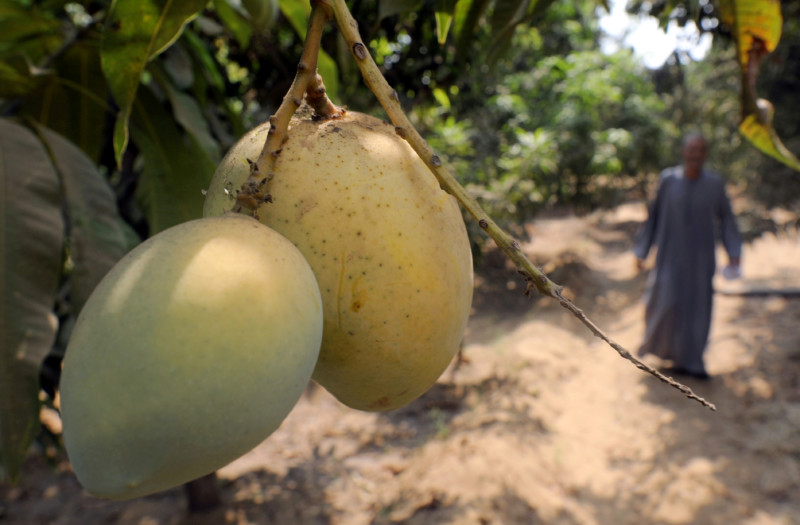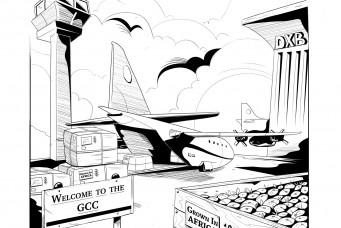In Malawi, the battle to save mangoes
Malawi, like other African fruit producers, is drawing on local and global resources to combat a pest which threatens vital fruit exports.

A farmer walks at a mango field in Al-Giza, on the outskirts of Cairo, Egypt, August 27, 2018. Mohamed Abd El Ghany/Reuters
Mango farmers in Malawi, who have always considered the fruit to be a source of revenue when food is scarce, have declared war on the Bactrocera dorsalis fly which threatens their crops and livelihood.
The mango is one of the most important fruits in Malawi, and is a source of income and nutrition for many smallholders—vulnerable farmers holding small plots of land used to produce an export commodity as a main source of income. Women and youth are among the main beneficiaries as they are involved in the harvesting, and sale, of fresh mangoes from their homes, by the roadsides and at small markets, thereby improving household income.
However, in recent years, many farmers have seen an increase in rotten mangoes and lost revenue due to what scientifically is called Bactrocera dorsalis, more commonly known as the fruit fly. According to the Centre for Agriculture Biosciences International (CABI), this is a highly invasive species native to Asia that is now found in at least sixty-five countries, including parts of America and Oceania, and most sub-Saharan African countries.
The potential risk of their introduction to a new area is caused by increasing international tourism and trade, and is influenced by changes in climate and land use.
The fruit fly introduction may also happen as a result of movements of people from one country to another, as may happen with refugees and other migrants, and is sometimes caused by cross-border trade. In terms of land use, certain human actions such as forest degradation that clears large areas of land can lead to certain species of pests to begin attacking trees that are left out for fruit consumption such as mango.
After introduction, fruit flies can easily disperse as they have a high reproductive potential, high biotic potential (short life cycle, up to ten generations of offspring per year depending on temperature), a rapid dispersal ability and a broad host range.
This means that they reproduce quickly and then easily spread to colonize new areas where they begin the cycle anew, often laying eggs ten times a year depending on the area temperature.
The project is implementing all possible measures holistically to contain the spread of what is now an invasive species. The use of integrated measures is one way of containing the high reproductive potential of the fruit flies.
The fruit flies lay eggs in the mangoes, which hatch into maggots that burrow inside the fruit causing rotting. In some cases the fruit may not fall on the ground but it may simply be infested with maggots as a live fruit. This makes the fruit inedible when plucked from the tree for consumption, and it is no longer a viable commodity for export. The damaged fruit then becomes unmarketable, resulting in loss of both food and income at the household level and along the supply chain.
The direct damage and the resulting quarantine restrictions (such as a ban on products originating from areas where the fruit species are infected by the flies) on rotting mangoes imposed by importing countries, such as Italy, India, South Africa, Tanzania and the United Arab Emirates (to name a few) are estimated to have cost Malawi and other African exporters more than $2 billion in annual foreign currency earnings. The economic impact results primarily from the loss of export markets and the costly implementation of quarantine restrictions and pest eradication measures. Restrictions come in the form of a ban on exports that are believed to contain products with infected plant disease.
In a bid to address the threat posed by fruit flies, researchers in Malawi, Mozambique, Zambia, and Zimbabwe are implementing the Alien invasive fruit flies in southern Africa project which calls for the implementation of a sustainable Integrated Pest Management (IPM) program to combat their spread.
The project has received funding of C$ 2.8 ($2.2) million from the Canadian International Development Research Centre and the Australian International Food Security Research Centre, for the wide scale adoption of IPM interventions including combating fruit fly infestations.
The project kicked off in 2019 and will wrap up in September 2022.
Source of Income, Nutrition and Export
According to a 2019 Michigan State University report on the mango value chain, smallholder farmers make gross margins (total sales revenue after subtracting incurred production costs) of 300,000 Malawian Kwacha—approximately $375—per farmed hectare. They earn a 78 percent profit margin, making mango farming profitable.
In addition to the presence of wild mangoes that are managed by Malawian subsistence farmers, the demand for both fresh and dried mangoes in global markets helped create the right market conditions for the establishment of the first commercial mango farming company—Malawi Mangoes—in 2009. This is Malawi’s largest mango farming company and is based in the Lakeshore district of Salima about 110 kilometers east from the capital Lilongwe.
The company has set up the first large scale fruit processing facility in Malawi. Its proximity to Lake Malawi, Africa’s third largest lake, has helped the company to grow prefered grafted species of mangoes using technologies such as drip irrigation as part of the Green Belt Initiative, a government project to boost self-sustenance in food security.
Charles Leaper, Malawi Mangoes Chief Executive Officer, told The Cairo Review by phone that they now have 230 hectares of land using drip irrigation technology—an approach which conserves water and minimizes water waste. So far, they are exporting 100 tonnes of fresh mangoes and 240 tonnes of dried mangoes to the United Kingdom and the European Union.
“We have close to 5,000 farmers who are on contract farming with us. Our plan is to increase our area under cultivation to 350 hectares of land. As such, the combined harvests of our farmers who sell to us plus our own harvest will lead to us producing close to 800 tonnes of finished dried mangoes product for export,” Leaper said.
With such tonnage, his company hopes to export to India and Singapore, as well as to penetrate new markets in North America and Canada. Leaper said they are aware of the prevalence of fruit flies as a major threat to the mango business. However, with a fully-fledged agronomy unit, a branch of agriculture that grows crops, they have put stringent controls, such as nets, to trap the flies.
Another local Malawian entrepreneur that processes ripped Mangoes in Lilongwe the capital is Thanthwe Farm located on the outskirts west of Lilongwe. George Mavuto is the Farm’s agronomist.
“Yes, indeed as Thanthwe Farm, we process dried mangoes and package them as part of value addition. As a farm, we grow mango on a small scale around 2 hectares,” said Mavuto in an interview.
“To empower the communities around the farm economically, we encourage them to grow mango fruits. We move around and provide technical advice on how they can maximize yields. Then we buy all the mangoes from them,” he explained. The bulk of our quantity for our annual requirements come from them.” Mavuto acknowledges that the major challenge is the incidence of pests—fruit flies being one of them. He adds that yield is affected as the fruit flies compromise quality. All infested fruits are graded out soon after harvesting as they are of poor quality.
“As a result of fruit flies, instead of meeting the demand, we supply below the requirement due to this pest,” he said.
Continental strategy on the culprit: Fruit flies
In a bid to address the widespread mango losses as a result of fruit flies, Malawi’s Department of Agriculture Research Services at Bvumbwe Station based in the southern district of Thyolo—with support from the International Centre of Insect Physiology and Ecology (ICIPE) a regional think tank on entomology research based in Nairobi, Kenya, —is working with farmers in Ntcheu and Lilongwe districts to contain the devastating effects of these pests.
The two districts are where wild mango trees are produced in large quantities. This is being done in hopes that extension staff can replicate these IPM interventions in other districts throughout the country.
The package includes various components of interventions such as baiting techniques, male annihilation, biopesticide application, orchard sanitation, and biological control using wasps called parasitoids, which attack fruit fly eggs and maggots.
Researchers have also extended a regional approach to the fruit fly Integrated Pest Management package, which has been adapted and promoted in the project’s target countries of Mozambique, Zambia and Zimbabwe which are close neighbours of Malawi.
Experts hope the proximity of these countries which share common borders and were once under a single federation (in the case of Malawi, Zimbabwe and Zambia) will help address the fruit fly challenge from a regional perspective.
They are also of the view that tackling the challenge in one country alone will only make the problem a challenge in another country as fruit flies do not respect international borders and territories.
Suppressing native fruit flies with pheromones
Pheromones, known as Host Marking Pheromones (HMP), are used by insects to mark ‘hosts’ (usually a fruit), where they have already laid their eggs. These were evaluated in Kenya for their application and efficacy in deterring fruit flies of the same or different species from laying their eggs on host fruits, such as mango and guava. The results, which are applicable to the target countries, indicate a seven to nine fold decrease in fruit infestation by three types of indigenous fruit flies in plots treated with HMP compared to controls. This information not only contributes to knowledge on the chemical ecology of fruit flies but indicates the potential for these pheromones to be incorporated within IPM fruit sprays. HMP thus widens the options for fruit fly management through integrated pest management.
Mass rearing of parasitoids
Colonies of two parasitoid species have been boosted by the ICIPE based in Nairobi, Kenya—the third largest exporter of mangoes in Africa. The laboratory has a capacity to produce approximately 25,000 wasps per month—sufficient to supply all target countries. However, Zambia has yet to upgrade its national laboratories in order to rear and multiply the wasp species and still needs to obtain an import permit to receive the parasitoid shipments from ICIPE. Malawi and Mozambique have upgraded their facilities in readiness of receiving the parasitoids and are now awaiting processing of the import permits and required phytosanitary certificates. Parasitoids have already been shipped to Zimbabwe where project staff have started rearing insects at a small scale but aim to be able to supply farmers with 1,500 wasps per hectare.
Male Annihilation
One other technique is male annihilation. This is the mass killing of male fruit flies in an area. The males are killed in mass by setting traps containing a parapheromone which attracts the fruit flies but also contains a killing agent which exterminates them when trapped. The technique works in a way that when many male fruit flies are killed in the environment, many females lay eggs which are not fertile and consequently the population of the pests reduces over time.
Since mango is important in these countries and fruit flies are constraining its production and utilization, the combined use of all these techniques as part of fruit fly management will enhance the incomes and nutrition of farmers, entrepreneurs and commercial growers through increased production and consumption.
What Comes Next
When asked about the possibility for extension after 2022, ICIPE postdoctoral fellow Shepard Ndlela explained that, like any other donor-funded project, the Alien invasive fruit flies project in southern Africa will come to an end next September. The governments of Malawi, Zambia, Zimbabwe, Mozambique are expected to extend activities beyond the project implementation phase.
Hundreds of extension officers have been trained in fruit fly IPM, model farmers have also trained to be a source of information including Masters and PhD students. Thousands of women also trained through gender transformative actions, he added.
“We are building the capacity of these countries so that extension officers can incorporate what has been learned into their day to day activities with farmers,” Ndlela told The Cairo Review from Nairobi. “We have made great strides in the other countries where thousands are now using the fruit fly IPM package.”
Charles Mkoka is a Malawian science communication specialist with a strong technical background in Environment and Natural Resource Management. Mkoka has over 15 years of extensive hands – on experience in development communication, working on agriculture, climate change, resilience building and general environment – related programming using diverse multi-media platforms. A science graduate from the University of Malawi, Chancellor College, Mkoka has published for reputable media outlets globally.
He can be found on Twitter @ https://twitter.com/chamkoka
Read MoreSubscribe to Our Newsletter




